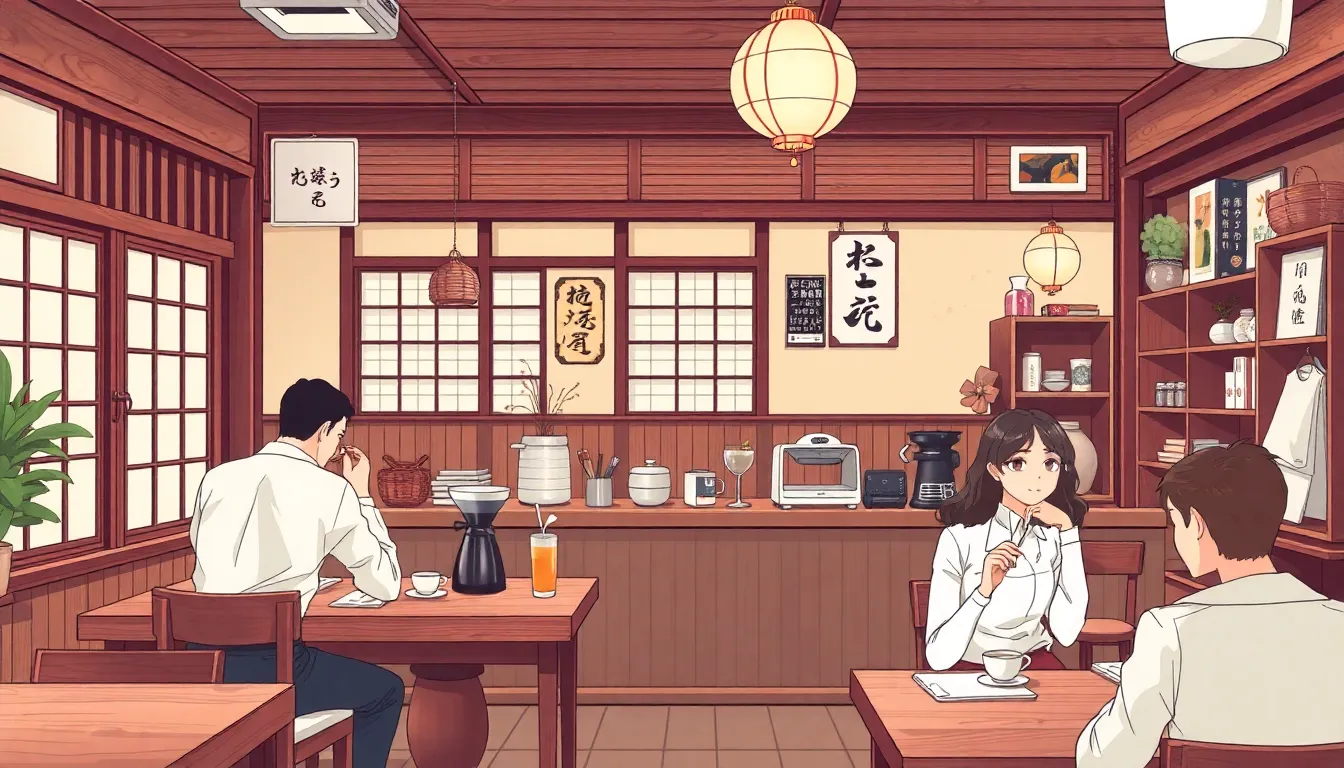Table of Contents
ToggleIn a world where coffee is often just a morning ritual, Japan takes it to a whole new level. Imagine sipping a perfectly brewed cup while watching a master barista perform a delicate dance of precision and artistry. Japanese coffee culture isn’t just about caffeine; it’s an experience that combines tradition, innovation, and a sprinkle of whimsy.
Overview Of Japanese Coffee Culture
Japanese coffee culture combines tradition with modernity, creating a unique experience for enthusiasts. Coffee became popular in Japan during the late 19th century, rapidly evolving from a novelty to a staple in daily life. Today, it’s not merely a drink but a comprehensive ritual.
Baristas in Japan take pride in their craft, emphasizing precision and attention to detail in every cup they serve. Many cafés feature methods like pour-over and siphon brewing, allowing patrons to witness the brewing process. Observing skilled baristas work highlights the artistry involved in each step.
Cafés play a crucial role in social interaction. People gather in these spaces not only to enjoy coffee but also to connect with others. The environment often fosters a sense of community, making it a popular spot for both locals and tourists.
Specialty coffee shops emphasize single-origin beans, elevating the flavor profile. Various brewing techniques and the influence of seasonal ingredients contribute to the distinct tastes of Japanese coffee. The growing interest in craft coffee has spurred innovations, leading to unique blends that reflect regional nuances.
Traditional coffee houses, or kissaten, present a nostalgic atmosphere, offering a glimpse of Japan’s coffee history. These venues often feature vintage décor and serve classic coffee styles alongside light snacks. They provide an intimate setting that contrasts with modern, fast-paced coffee chains.
Japan also celebrates coffee festivals, showcasing local roasters and promoting understanding of coffee production. These events highlight the journey from bean to cup, emphasizing transparency and sustainability within the coffee industry.
History Of Coffee In Japan


Japan’s journey with coffee began in the late 19th century. Initially, coffee captured attention as a novelty, introduced by Dutch traders. Around 1850, cafes emerged in major cities, catering to domestic and foreign tastes. Popularity surged as Japanese consumers grew intrigued by the drink’s rich flavors.
Introduction Of Coffee To Japan
The 18th century marks a significant point in coffee’s introduction, when it appeared in Nagasaki. Traders brought coffee beans, fueling curiosity among locals. By the Meiji Era, the demand for coffee increased as Western influences permeated Japanese society. Brewed beverages started appearing in kiosks and homes, paving the way for a burgeoning coffee culture. Resulting from this interest, the first dedicated coffee shop opened in Yokohama in 1888. This establishment laid the groundwork for what would evolve into a vibrant coffee scene.
Evolution Of Coffee Shops
Cafés in Japan underwent significant transformation over the decades. Early coffee shops focused on simple coffee preparations, primarily serving drip coffee. As tastes evolved, so did the variety and quality of offerings. In the mid-20th century, kissaten characterized coffee culture with their retro charm, often featuring elaborate menus. Modern specialty coffee shops further revolutionized the landscape, emphasizing single-origin beans and artisanal brewing techniques. Concurrently, a sense of community blossomed, with cafés acting as gatherings for social interactions. Today’s landscape boasts diverse options, from traditional kissaten to innovative, trend-setting cafés.
Unique Aspects Of Japanese Coffee Culture
Japan’s coffee culture stands out with its commitment to skill and artistry. Unique brewing techniques and aromatic rituals define this rich tradition, offering more than just a simple beverage.
Brewing Techniques
Pour-over is a favorite method among Japanese coffee enthusiasts. This technique emphasizes precision, as baristas carefully control water temperature and pouring speed. Siphon brewing also captivates customers, combining science with spectacle. The vacuum effect in siphon brewing not only creates flavor but also offers a visual treat. Many specialty cafés showcase these methods, allowing patrons to appreciate the craft of their coffee. Baristas possess deep knowledge about sourcing and roasting beans, further enhancing the coffee experience. Such dedication fosters a connection between the drinker and the origins of their coffee.
Coffee Tasting Rituals
Tasting coffee in Japan transforms into an immersive experience. Many cafés host guided tasting sessions where participants explore various flavor profiles. Attendees compare single-origin beans, learning about the nuances from different regions. This structured tasting process emphasizes mindfulness, encouraging individuals to savor each sip fully. Coffee tastings often consider acidity, aroma, and texture, helping participants refine their palates. Baristas skillfully engage customers, sharing insights on brewing techniques and bean selection. Such rituals strengthen the appreciation for quality coffee and enhance community bonds among enthusiasts.
Popular Coffee Varieties In Japan
Japanese coffee culture offers a wide array of unique coffee varieties, showcasing the country’s dedication to quality and craftsmanship.
Specialty Coffees
Specialty coffees in Japan feature single-origin beans sourced from around the globe. Enthusiasts appreciate the distinct flavor profiles of these beans, often resulting from specific growing conditions. Notable among these is the popular Ethiopian Yirgacheffe, known for its fruity and floral notes. Japanese cafés often emphasize direct trade, fostering relationships with farmers to ensure high-quality products while promoting sustainability. Baristas expertly brew these specialty coffees using methods like pour-over and siphon, enhancing the tasting experience through precise techniques. Such attention to detail elevates coffee drinking to an art form, attracting both locals and tourists.
Regional Differences
Regional coffee differences highlight Japan’s diverse coffee landscape. In Kyoto, traditional kissaten offer a nostalgic feel, featuring classic blends and rich brewing techniques. Tokyo’s vibrant specialty coffee scene presents innovative cafés that experiment with brewing styles and unique flavors. Each region’s coffee reflects local tastes; for instance, Okinawa is known for its sweet, blended coffee drinks that echo the tropical climate. Furthermore, Hokkaido boasts its famous milk coffee, showcasing the region’s rich dairy products. Understanding these regional variations deepens appreciation for Japan’s multifaceted coffee culture.
The Role Of Coffee Shops In Japanese Society
Coffee shops in Japan serve essential functions beyond mere beverage consumption. They act as community hubs, bringing together diverse individuals who share an appreciation for quality coffee. Baristas often engage patrons, creating a welcoming atmosphere that fosters conversation and connection.
Specialty cafés frequently focus on single-origin beans, which attracts coffee enthusiasts eager to explore unique flavors. Customers appreciate the artistry behind brewing methods such as pour-over and siphon, which are showcased prominently during their visits. Traditional kissaten offer a nostalgic escape, presenting classic blends in vintage settings that reflect Japan’s coffee history.
These venues not only provide beverages but also encourage cultural exchange. Visitors often find themselves immersed in detailed brewing rituals, learning about the importance of coffee selection and preparation. Educational tastings hosted at some cafés deepen participants’ understanding of the coffee-making process.
Local coffee festivals highlight regional roasters, emphasizing sustainability and the connection between farmers and consumers. Shops frequently partner with these local producers, which strengthens community relationships while promoting ethical sourcing. From Tokyo’s vibrant specialty locales to Kyoto’s serene kissaten, the diversity in style and atmosphere enriches Japan’s coffee landscape.
Moreover, coffee shops contribute to the economy through job creation and local commerce. They attract both residents and tourists, boosting foot traffic in surrounding areas. The popularity of these establishments illustrates their significance in daily life, shaping social interactions, and fostering communal ties.
Japanese coffee culture embodies a harmonious blend of tradition and innovation. It transforms the act of drinking coffee into a rich experience filled with artistry and community connection. From the meticulous brewing methods to the immersive tasting rituals, each cup tells a story of craftsmanship and dedication.
As coffee shops continue to thrive as social hubs, they play a vital role in fostering relationships and promoting sustainability. The appreciation for quality coffee in Japan extends beyond the beverage itself, inviting enthusiasts to explore and celebrate the diverse flavors and techniques that define this unique culture. Through these experiences, Japan’s coffee scene not only satisfies the palate but also enriches the soul.




